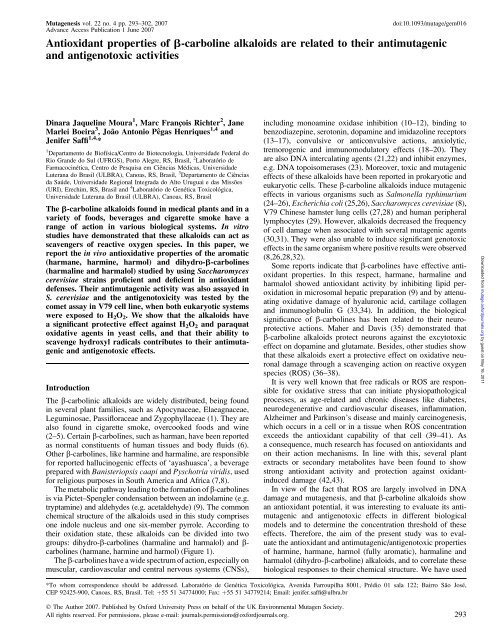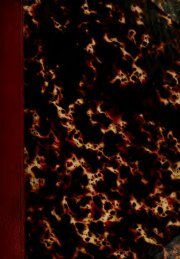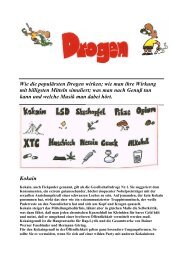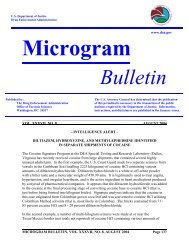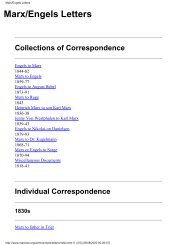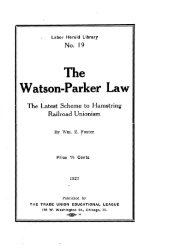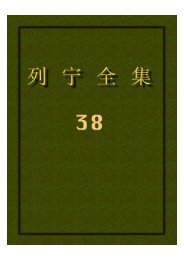MOURA Dinara Jaqueline et al.
MOURA Dinara Jaqueline et al.
MOURA Dinara Jaqueline et al.
Create successful ePaper yourself
Turn your PDF publications into a flip-book with our unique Google optimized e-Paper software.
Mutagenesis vol. 22 no. 4 pp. 293–302, 2007 doi:10.1093/mutage/gem016<br />
Advance Access Publication 1 June 2007<br />
Antioxidant properties of b-carboline <strong>al</strong>k<strong>al</strong>oids are related to their antimutagenic<br />
and antigenotoxic activities<br />
<strong>Dinara</strong> <strong>Jaqueline</strong> Moura 1 , Marc Francxois Richter 2 , Jane<br />
Marlei Boeira 3 , João Antonio Pêgas Henriques 1,4 and<br />
Jenifer Saffi 1,4, *<br />
1<br />
Departamento de Biofísica/Centro de Biotecnologia, Universidade Feder<strong>al</strong> do<br />
Rio Grande do Sul (UFRGS), Porto Alegre, RS, Brasil, 2 Laboratório de<br />
Farmacocinética, Centro de Pesquisa em Ciências Médicas, Universidade<br />
Luterana do Brasil (ULBRA), Canoas, RS, Brasil, 3 Departamento de Ciências<br />
da Saúde, Universidade Region<strong>al</strong> Integrada do Alto Uruguai e das Missões<br />
(URI), Erechim, RS, Brasil and 4 Laboratório de Genética Toxicológica,<br />
Universidade Luterana do Brasil (ULBRA), Canoas, RS, Brasil<br />
The b-carboline <strong>al</strong>k<strong>al</strong>oids found in medic<strong>al</strong> plants and in a<br />
vari<strong>et</strong>y of foods, beverages and cigar<strong>et</strong>te smoke have a<br />
range of action in various biologic<strong>al</strong> systems. In vitro<br />
studies have demonstrated that these <strong>al</strong>k<strong>al</strong>oids can act as<br />
scavengers of reactive oxygen species. In this paper, we<br />
report the in vivo antioxidative properties of the aromatic<br />
(harmane, harmine, harmol) and dihydro-b-carbolines<br />
(harm<strong>al</strong>ine and harm<strong>al</strong>ol) studied by using Saccharomyces<br />
cerevisiae strains proficient and deficient in antioxidant<br />
defenses. Their antimutagenic activity was <strong>al</strong>so assayed in<br />
S. cerevisiae and the antigenotoxicity was tested by the<br />
com<strong>et</strong> assay in V79 cell line, when both eukaryotic systems<br />
were exposed to H2O2. We show that the <strong>al</strong>k<strong>al</strong>oids have<br />
a significant protective effect against H2O2 and paraquat<br />
oxidative agents in yeast cells, and that their ability to<br />
scavenge hydroxyl radic<strong>al</strong>s contributes to their antimutagenic<br />
and antigenotoxic effects.<br />
Introduction<br />
The b-carbolinic <strong>al</strong>k<strong>al</strong>oids are widely distributed, being found<br />
in sever<strong>al</strong> plant families, such as Apocynaceae, Elaeagnaceae,<br />
Leguminosae, Passifloraceae and Zygophyllaceae (1). They are<br />
<strong>al</strong>so found in cigar<strong>et</strong>te smoke, overcooked foods and wine<br />
(2–5). Certain b-carbolines, such as harman, have been reported<br />
as norm<strong>al</strong> constituents of human tissues and body fluids (6).<br />
Other b-carbolines, like harmine and harm<strong>al</strong>ine, are responsible<br />
for reported h<strong>al</strong>lucinogenic effects of ‘ayashuasca’, a beverage<br />
prepared with Banisteriopsis caapi and Pyschotria viridis, used<br />
for religious purposes in South America and Africa (7,8).<br />
The m<strong>et</strong>abolic pathway leading to the formation of b-carbolines<br />
is via Pict<strong>et</strong>–Spengler condensation b<strong>et</strong>ween an indolamine (e.g.<br />
tryptamine) and <strong>al</strong>dehydes (e.g. ac<strong>et</strong><strong>al</strong>dehyde) (9). The common<br />
chemic<strong>al</strong> structure of the <strong>al</strong>k<strong>al</strong>oids used in this study comprises<br />
one indole nucleus and one six-member pyrrole. According to<br />
their oxidation state, these <strong>al</strong>k<strong>al</strong>oids can be divided into two<br />
groups: dihydro-b-carbolines (harm<strong>al</strong>ine and harm<strong>al</strong>ol) and bcarbolines<br />
(harmane, harmine and harmol) (Figure 1).<br />
The b-carbolines have a wide spectrum of action, especi<strong>al</strong>ly on<br />
muscular, cardiovascular and centr<strong>al</strong> nervous systems (CNSs),<br />
including monoamine oxidase inhibition (10–12), binding to<br />
benzodiazepine, serotonin, dopamine and imidazoline receptors<br />
(13–17), convulsive or anticonvulsive actions, anxiolytic,<br />
tremorogenic and immunomodulatory effects (18–20). They<br />
are <strong>al</strong>so DNA interc<strong>al</strong>ating agents (21,22) and inhibit enzymes,<br />
e.g. DNA topoisomerases (23). Moreover, toxic and mutagenic<br />
effects of these <strong>al</strong>k<strong>al</strong>oids have been reported in prokaryotic and<br />
eukaryotic cells. These b-carboline <strong>al</strong>k<strong>al</strong>oids induce mutagenic<br />
effects in various organisms such as S<strong>al</strong>monella typhimurium<br />
(24–26), Escherichia coli (25,26), Saccharomyces cerevisiae (8),<br />
V79 Chinese hamster lung cells (27,28) and human peripher<strong>al</strong><br />
lymphocytes (29). However, <strong>al</strong>k<strong>al</strong>oids decreased the frequency<br />
of cell damage when associated with sever<strong>al</strong> mutagenic agents<br />
(30,31). They were <strong>al</strong>so unable to induce significant genotoxic<br />
effects in the same organism where positive results were observed<br />
(8,26,28,32).<br />
Some reports indicate that b-carbolines have effective antioxidant<br />
properties. In this respect, harmane, harm<strong>al</strong>ine and<br />
harm<strong>al</strong>ol showed antioxidant activity by inhibiting lipid peroxidation<br />
in microsom<strong>al</strong> hepatic preparation (9) and by attenuating<br />
oxidative damage of hy<strong>al</strong>uronic acid, cartilage collagen<br />
and immunoglobulin G (33,34). In addition, the biologic<strong>al</strong><br />
significance of b-carbolines has been related to their neuroprotective<br />
actions. Maher and Davis (35) demonstrated that<br />
b-carboline <strong>al</strong>k<strong>al</strong>oids protect neurons against the excytotoxic<br />
effect on dopamine and glutamate. Besides, other studies show<br />
that these <strong>al</strong>k<strong>al</strong>oids exert a protective effect on oxidative neuron<strong>al</strong><br />
damage through a scavenging action on reactive oxygen<br />
species (ROS) (36–38).<br />
It is very well known that free radic<strong>al</strong>s or ROS are responsible<br />
for oxidative stress that can initiate physiopathologic<strong>al</strong><br />
processes, as age-related and chronic diseases like diab<strong>et</strong>es,<br />
neurodegenerative and cardiovascular diseases, inflammation,<br />
Alzheimer and Parkinson’s disease and mainly carcinogenesis,<br />
which occurs in a cell or in a tissue when ROS concentration<br />
exceeds the antioxidant capability of that cell (39–41). As<br />
a consequence, much research has focused on antioxidants and<br />
on their action mechanisms. In line with this, sever<strong>al</strong> plant<br />
extracts or secondary m<strong>et</strong>abolites have been found to show<br />
strong antioxidant activity and protection against oxidantinduced<br />
damage (42,43).<br />
In view of the fact that ROS are largely involved in DNA<br />
damage and mutagenesis, and that b-carboline <strong>al</strong>k<strong>al</strong>oids show<br />
an antioxidant potenti<strong>al</strong>, it was interesting to ev<strong>al</strong>uate its antimutagenic<br />
and antigenotoxic effects in different biologic<strong>al</strong><br />
models and to d<strong>et</strong>ermine the concentration threshold of these<br />
effects. Therefore, the aim of the present study was to ev<strong>al</strong>uate<br />
the antioxidant and antimutagenic/antigenotoxic properties<br />
of harmine, harmane, harmol (fully aromatic), harm<strong>al</strong>ine and<br />
harm<strong>al</strong>ol (dihydro-b-carboline) <strong>al</strong>k<strong>al</strong>oids, and to correlate these<br />
biologic<strong>al</strong> responses to their chemic<strong>al</strong> structure. We have used<br />
*To whom correspondence should be addressed. Laboratório de Genética Toxicológica, Avenida Farroupilha 8001, Prédio 01 s<strong>al</strong>a 122; Bairro São José,<br />
CEP 92425-900, Canoas, RS, Brasil. Tel: þ55 51 34774000; Fax: þ55 51 34779214; Email: jenifer.saffi@ulbra.br<br />
Ó The Author 2007. Published by Oxford University Press on beh<strong>al</strong>f of the UK Environment<strong>al</strong> Mutagen Soci<strong>et</strong>y.<br />
All rights reserved. For permissions, please e-mail: journ<strong>al</strong>s.permissions@oxfordjourn<strong>al</strong>s.org. 293<br />
Downloaded from<br />
mutage.oxfordjourn<strong>al</strong>s.org by guest on May 16, 2011
D. J. Moura <strong>et</strong> <strong>al</strong>.<br />
H2O2 and paraquat to induce oxidative damage in S. cerevisiae<br />
strains defective in sever<strong>al</strong> antioxidant defenses. We have<br />
<strong>al</strong>so ev<strong>al</strong>uated the mutagenicity and antimutagenicity of the<br />
<strong>al</strong>k<strong>al</strong>oids using the yeast strain N123, as well as their protective<br />
effect against oxidative DNA damage, verified by the com<strong>et</strong><br />
assay in a culture of permanent lung fibroblast cell line derived<br />
from Chinese hamsters.<br />
Materi<strong>al</strong>s and m<strong>et</strong>hods<br />
Chemic<strong>al</strong>s<br />
The <strong>al</strong>k<strong>al</strong>oids harmane (CAS 21655-84-5), harmine (CAS 343-27-1), harmol<br />
(CAS 149022-16-2), harm<strong>al</strong>ine (CAS 6027-98-1) and harm<strong>al</strong>ol (CAS 6028-07-5)<br />
hydrochlorides, H2O2, paraquat (m<strong>et</strong>hyl viologen), m<strong>et</strong>hyl m<strong>et</strong>hanesulfonate<br />
(MMS), 4-nitroquinoline-N-oxide (4-NQO), hypoxanthine, xanthine oxidase and<br />
s<strong>al</strong>icylic acid were obtained from Sigma (St Louis, MO, USA). Dulbecco’s<br />
modified Eagle’s medium (DMEM), f<strong>et</strong><strong>al</strong> bovine serum (FBS), trypsin–<strong>et</strong>hylenediamine<br />
t<strong>et</strong>raac<strong>et</strong>ic acid (EDTA), L-glutamine, antibiotics and trypan blue<br />
were purchased from Gibco BRL (Grand Island, NY, USA). Low-melting<br />
point agarose (LMA) and agarose were obtained from Invitrogen (Carlsbad, CA,<br />
USA). Yeast extract, bacto-peptone and bacto-agar were obtained from Difco<br />
Laboratories (D<strong>et</strong>roit, MI, USA). All others reagents were of an<strong>al</strong>ytic<strong>al</strong> grade.<br />
For treatment of cells, 5 mg/ml stock solutions of the <strong>al</strong>k<strong>al</strong>oids were prepared<br />
immediately prior to use. Harmine was dissolved in distilled water and<br />
harman, harmol, harm<strong>al</strong>ine and harm<strong>al</strong>ol were dissolved in 5% dim<strong>et</strong>hylsulf-<br />
Fig. 1. Chemic<strong>al</strong> structure of the b-carboline <strong>al</strong>k<strong>al</strong>oids. (A) Aromatic<br />
b-carboline. (B) dihydro-b-carbolines.<br />
Table I. Saccharomyces cerevisiae strains used in this study<br />
oxide (DMSO) and distilled water; the fin<strong>al</strong> concentration of DMSO in the<br />
incubation mixture never exceeds 0.2%. The appropriate concentrations were<br />
obtained by dilution of stock solutions in distilled water. The solvent controls<br />
included in the gen<strong>et</strong>ic tests were found to be negative; 4-NQO, MMS, paraquat<br />
and H2O2 were used as positive control.<br />
Medium and strains of S. cerevisiae<br />
The relevant genotypes of S. cerevisiae strains used in this study are listed in<br />
Table I. Media, solutions and buffers were prepared as previously described<br />
(44). The compl<strong>et</strong>e medium (YPD) containing 0.5% yeast extract, 2% peptone<br />
and 2% glucose was used for routine growth. For plates, the medium was<br />
solidified with 2% bacto-agar. The minim<strong>al</strong> medium (MM) contained 0.67%<br />
yeast nitrogen base without amino acids, 2% glucose and 2% bacto-agar. The<br />
synth<strong>et</strong>ic compl<strong>et</strong>e medium (SC) was MM supplemented with 2 mg adenine,<br />
5 mg lysine, 1 mg histidine, 2 mg leucine, 2 mg m<strong>et</strong>hionine, 2 mg uracil and<br />
2 mg tryptophan per 100 ml MM. For mutagenesis, plates were supplemented<br />
with 60 lg/ml canavanine (SC þ can).<br />
We chose to work in the stationary phase of growth because this resembles<br />
most cells of multicellular organisms in important aspects: (i) most energy<br />
comes from mitochondri<strong>al</strong> respiration, (ii) the cells have left the active cell<br />
cycle and have entered the G 0 phase and (iii) damage accumulates over time<br />
(45,46). The herbicide paraquat, a redox cycling compound, was used to increase<br />
the intracellular flux of superoxide anion (O2 –. ). The appropriate concentrations<br />
of H2O2 and paraquat were d<strong>et</strong>ermined by surviv<strong>al</strong> assay, according<br />
to the differenti<strong>al</strong> sensitivity of each strain. Sub-l<strong>et</strong>h<strong>al</strong> concentration of the<br />
oxidants was used for <strong>al</strong>l subsequent experiments.<br />
Surviv<strong>al</strong> assays in S. cerevisiae strains<br />
Stationary phase cultures of EG103 [wild type (WT)] and mutant isogenic strains,<br />
as well as YPH98 (WT) and the isogenic mutant strain, were obtained by inoculation<br />
of an isolated colony into liquid YPD. To ev<strong>al</strong>uate sensitivity to bcarboline<br />
<strong>al</strong>k<strong>al</strong>oids, cultures were exposed to concentrations varying from 25 to<br />
150 lg/ml and incubated under growth conditions for 1 h in phosphate-buffered<br />
s<strong>al</strong>ine (PBS) at 30°C. Cells were appropriately diluted and plated in triplicate<br />
on solid YPD (2–3 days, 30°C) after colony-forming units were counted.<br />
To verify the antioxidant activity of the <strong>al</strong>k<strong>al</strong>oids, cells were pre-treated in<br />
PBS with non-cytotoxic concentrations of <strong>al</strong>k<strong>al</strong>oids and incubated for 1 h at<br />
30°C. Cells were then washed and treated with paraquat or H2O2 in PBS for<br />
another hour. For surviv<strong>al</strong> d<strong>et</strong>ermination, suitable <strong>al</strong>iquots were plated in<br />
triplicate on solid YPD. Plates were incubated at 30°C for 2–3 days before<br />
counting the colonies. All tests were repeated at least 3-fold, and plating was<br />
carried out in triplicate for each dose.<br />
D<strong>et</strong>ection of forward mutation and potenti<strong>al</strong> antimutagenic activity in<br />
S. cerevisiae<br />
Saccharomyces cerevisiae N123 strain was used for assaying <strong>al</strong>k<strong>al</strong>oid mutagenicity<br />
as well as the protective effect of the <strong>al</strong>k<strong>al</strong>oids against H 2O 2-induced<br />
mutagenesis. This strain was chosen because it is very responsive to H 2O 2induced<br />
mutagenesis due to its low glutathione content (47). A suspension of<br />
2 10 8 cells/ml in the stationary phase, grown in YPD (2% glucose), was<br />
incubated for 1 h at 30°C with various concentrations of <strong>al</strong>k<strong>al</strong>oids in PBS.<br />
Surviv<strong>al</strong> was d<strong>et</strong>ermined on SC (2–5 days, 30°C), and mutation induction<br />
(CAN revertants) on appropriate supplementation media (4–5 days, 30°C).<br />
Forward mutation was measured with the canavanine resistance assay (CAN1can1)<br />
after induction with different treatments. This assay uses a phenotypic<br />
marker, canavanine sensitivity, since WT yeast strains express the arginine<br />
transporter Can1p, which <strong>al</strong>so imports canavanine from the environment and<br />
leads to cell death (48). Thus, mutagen-induced <strong>al</strong>terations in the CAN1 gene<br />
that impair Can1p function<strong>al</strong>ity can increase cell surviv<strong>al</strong> in the presence of<br />
canavanine, when compared to a non-mutagenic cell sample.<br />
Strain Genotype Enzymatic defense lacking Source<br />
EG103 (SOD-WT) MATa leu2D0 his3-D1 trp1-289 ura3-52 None E. Gr<strong>al</strong>la<br />
EG118 (sod1D) Like EG103, except sod1::URA3 Cu–Zn SOD (cytosolic) E. Gr<strong>al</strong>la<br />
EG110 (sod2D) Like EG103, except sod2::TRP1 MnSOD (mitochondri<strong>al</strong>) E. Gr<strong>al</strong>la<br />
EG133 (sod1D sod2D) Like EG103, except sod1::URA3 e sod2::TRP1 All SOD E. Gr<strong>al</strong>la<br />
EG223 (ctt1D) Like EG103, except ctt1::TRP1 Cytosolic cat<strong>al</strong>ase E. Gr<strong>al</strong>la<br />
EG213 (sod1D ctt1D) Like EG103, except sod1::URA3 e ctt1::TRP1 Cu–Zn SOD and cytosolic cat<strong>al</strong>ase E. Gr<strong>al</strong>la<br />
YPH98 (WT) MATa ade2-101 leu2-D1 lys2-801 trp1-D1 ura3-52 None P. Hi<strong>et</strong>er<br />
yap1D Like YPH98 except yap1::URA3 yAP-1 transcription factor M. Grey<br />
N123 MATa his1-7 None, but exhibits low glutathione content J. Henriques<br />
294<br />
Downloaded from<br />
mutage.oxfordjourn<strong>al</strong>s.org by guest on May 16, 2011
For antimutagenic ev<strong>al</strong>uation, the procedure was as follows: cells were<br />
submitted to pre-treatment with non-cytotoxic concentrations of <strong>al</strong>k<strong>al</strong>oids and<br />
incubated for 1 h with shaking at 30°C. Cells were then washed and H 2O 2 was<br />
added. The mixture was further incubated at 30°C for 1 h. After treatment,<br />
appropriate dilutions of cells were plated onto SC plates to d<strong>et</strong>ermine cell<br />
surviv<strong>al</strong>, and 100 ll <strong>al</strong>iquots of cell suspension (2 10 8 cells/ml) were plated<br />
onto SC media supplemented with 60 lg/ml canavanine. Plates were incubated<br />
in the dark at 30°C for 3–5 days before counting the survivors and revertant<br />
colonies. All mutagenicity assays were repeated at least three times, and plating<br />
for each dose was conducted in triplicate.<br />
Com<strong>et</strong> assay using V79 cells<br />
Chinese hamster lung fibroblasts (V79 cells) were cultivated under standard<br />
condition in DMEM supplemented with 10% FBS, 2 mM L-glutamine and<br />
antibiotics (49). Cells were maintained in tissue culture flasks at 37°C in<br />
a humidified atmosphere containing 5% CO 2, and were harvested by treatment<br />
with 0.15% trypsin and 0.08% EDTA in PBS. Cells (2 10 5 ) were seeded into<br />
each flask and cultured 1 day prior to treatment. Alk<strong>al</strong>oids were added to FBSfree<br />
medium to achieve the different designed concentrations, and the cells<br />
were treated for 2 h at 37°C in a humidified atmosphere containing 5% CO2.<br />
Oxidative ch<strong>al</strong>lenge with 0.1 mM H2O2 was carried out for 0.5 h in the dark in<br />
FBS-free medium. The culture flasks were protected from direct light during<br />
treatment with the <strong>al</strong>k<strong>al</strong>oids and H 2O 2.<br />
The <strong>al</strong>k<strong>al</strong>ine com<strong>et</strong> assay was performed as described by Singh <strong>et</strong> <strong>al</strong>. (50)<br />
with minor modifications (51). At the end of treatment, cells were washed with<br />
ice-cold PBS and trypsinized with 100 ll trypsin (0.15%). Immediately<br />
thereafter, 20 ll of cell suspension ( 10 6 cells/ml) were dissolved in 0.75%<br />
LMA and spread on norm<strong>al</strong> agarose point (1%) pre-coated microscope slides.<br />
Cells were ice-cold lysed (2.5 M NaCl, 100 mM EDTA and 10 mM Tris, pH<br />
10.0, with freshly added 1% Triton X-100 and 10% DMSO) for at least 1 h at<br />
4°C in order to remove cellular proteins and membranes, leaving the DNA as<br />
‘nucleoids’. Thereafter, slides were placed in a horizont<strong>al</strong> electrophoresis box,<br />
containing freshly prepared <strong>al</strong>k<strong>al</strong>ine buffer (300 mM NaOH and 1 mM EDTA,<br />
pH 13.0) for 20 min at 4°C in order to <strong>al</strong>low DNA unwinding and expression<br />
of <strong>al</strong>k<strong>al</strong>i-labile sites. An electric current of 300 mA and 25 V (0.90 V/cm) was<br />
applied for 20 min to electrophorese DNA. All the steps above were performed<br />
under yellow light or in the dark in order to prevent addition<strong>al</strong> DNA damage.<br />
Slides were then neutr<strong>al</strong>ized (0.4 M Tris, pH 7.5), stained with silver nitrate as<br />
described by Nadin <strong>et</strong> <strong>al</strong>. (52) and an<strong>al</strong>yzed using an optic microscope. Images<br />
of 100 randomly selected cells (50 cells from each of two replicate slides) were<br />
an<strong>al</strong>yzed per group. Cells were <strong>al</strong>so scored visu<strong>al</strong>ly into five classes, according<br />
to tail size (from undamaged, 0, to maxim<strong>al</strong>ly damaged, 4).<br />
Internation<strong>al</strong> guidelines and recommendations for the com<strong>et</strong> assay consider<br />
that visu<strong>al</strong> scoring of com<strong>et</strong>s is a well-v<strong>al</strong>idated ev<strong>al</strong>uation m<strong>et</strong>hod (53). It has<br />
a high correlation with computer-based image an<strong>al</strong>ysis. The damage index (DI)<br />
is based on the length of migration and on the amount of DNA in the tail and is<br />
considered a sensitive measure of DNA and of damage frequency (DF), as the<br />
proportion of cells that show tails after electrophoresis. Image length (IL) or<br />
migration length gives information only about the size of DNA fragments, and<br />
is largely dependent upon electrophoresis conditions (i.e. voltage and duration).<br />
Thus, DI and DF are emphasized in our an<strong>al</strong>yses. The other param<strong>et</strong>er, IL,<br />
though considered in the an<strong>al</strong>ysis, was used only as a complementary DNA<br />
damage param<strong>et</strong>er. DI was thus assigned to each com<strong>et</strong> according to its class,<br />
and ranged from 0 (compl<strong>et</strong>ely undamaged: 100 cells 0) to 400 (with maximum<br />
damage: 100 cells 4) (54). The DF (%) was c<strong>al</strong>culated as the number<br />
of cells with tails versus those without (0–100%). Results are presented<br />
as means and ranges of four independent experiments. The solvent was used as<br />
negative control; MMS (4 10 5 M) and H2O2 (0.1 mM) were used as positive<br />
control.<br />
Hipoxanthine/xanthine oxidase assay<br />
The m<strong>et</strong>hod employed to assay the hydroxyl radic<strong>al</strong>-scavenging ability of<br />
<strong>al</strong>k<strong>al</strong>oids was based on the m<strong>et</strong>hod of Owen <strong>et</strong> <strong>al</strong>. (55). Briefly, <strong>al</strong>k<strong>al</strong>oids were<br />
dissolved in the assay buffer [hypoxanthine, Fe(III), EDTA and s<strong>al</strong>icylic acid]<br />
at a concentration of 2.0 mg/ml and diluted appropriately (in triplicate) in assay<br />
buffer to a fin<strong>al</strong> volume of 1.0 ml giving a range of 0.5–1.5 mg/ml. A 5-ll<br />
<strong>al</strong>iquot of xanthine oxidase dissolved in 3.2 M (NH4)2SO4 was added to initiate<br />
the reaction. The sample tubes were incubated at 37°C for 3 h, at which time<br />
the reaction was compl<strong>et</strong>e. A 30-ll <strong>al</strong>iquot of the reaction mixture was an<strong>al</strong>yzed<br />
by high-pressure liquid chromatography (HPLC) using chromatographic conditions<br />
as previously described (56). Chromatographic an<strong>al</strong>ysis was done using<br />
a gradient based on m<strong>et</strong>hanol–water–ac<strong>et</strong>ic acid with a lBondaPak C18 reverse<br />
phase column (Waters) and d<strong>et</strong>ection at 325 nm. The HPLC equipment had a<br />
2695 separation module (Waters) and UV d<strong>et</strong>ector 2487 (Waters). The hydroxylation<br />
of s<strong>al</strong>icylic acid and hypoxanthine was monitored at A 5 325 and<br />
A 5 278 nm, respectively. The amount of dihydroxyphenol, 2,5-dihydrox-<br />
Antioxidant properties of b-carboline <strong>al</strong>k<strong>al</strong>oids<br />
ybenzoic acid and 2,3-dihydroxybenzoic acid (DHBAs), produced by the<br />
reaction of s<strong>al</strong>icylic acid with produced hydroxyl radic<strong>al</strong>s (OH_) was d<strong>et</strong>ermined<br />
from standard curves of the respective dihydroxyphenols.<br />
Statistics<br />
Statistic<strong>al</strong> an<strong>al</strong>yses of the data were performed using one-way an<strong>al</strong>ysis of<br />
variance (ANOVA)–Tukey’s multiple comparison test. P-v<strong>al</strong>ues under 0.05<br />
were considered significant. Data were expressed as means SDs v<strong>al</strong>ues.<br />
Results<br />
Protective effects of b-carbonilic <strong>al</strong>k<strong>al</strong>oids in S. cerevisiae<br />
strains<br />
WT cells and isogenic mutant strains of S. cerevisiae lacking<br />
antioxidant defenses (Table I) were treated with sever<strong>al</strong> concentrations<br />
of the <strong>al</strong>k<strong>al</strong>oids for 1 h during the stationary phase.<br />
All strains showed practic<strong>al</strong>ly the same sensitivity for bcarbolines<br />
to that observed for the WT cells (Figure 2). Our<br />
findings showed that harmane, harmine and harmol decrease<br />
viability but, in a significant way, only in concentrations up to<br />
150 lg/ml, whereas harm<strong>al</strong>ine and harm<strong>al</strong>ol do not induce<br />
significant effects in any of the concentrations employed.<br />
In this manner, we chose non-cytotoxic <strong>al</strong>k<strong>al</strong>oid concentrations<br />
(ranging from 25 to 100 lg/ml) to follow experiments in<br />
order to verify the protecting activity against oxidants in the<br />
same strains.<br />
To verify an intracellular protective effect of the <strong>al</strong>k<strong>al</strong>oids,<br />
i.e. a possible role of b-carboline <strong>al</strong>k<strong>al</strong>oids in cell oxidative<br />
stress, yeast cells were pre-treated with non-cytotoxic concentration<br />
of harmane, harmine, harmol, harm<strong>al</strong>ine or harm<strong>al</strong>ol,<br />
and then further exposed to sub-l<strong>et</strong>h<strong>al</strong> concentrations of either<br />
H2O2 or paraquat. A statistic<strong>al</strong>ly significant surviv<strong>al</strong> was observed<br />
as a consequence of antioxidant effect of the <strong>al</strong>k<strong>al</strong>oids.<br />
The aromatic b-carboline harmane significantly enhanced<br />
the surviv<strong>al</strong> of <strong>al</strong>l yeast cells, with EG103 background at 50<br />
and 100 lg/ml after treatment with H2O2 (Figure 3A), showing<br />
a clear antioxidant protective effect. However, after treatment<br />
with paraquat, this effect was less significant, being more<br />
effective at 50 lg/ml in these strains (Figure 4A). Although<br />
harmane did not protect YPH98 WT against any of the two<br />
oxidative agents, an important antioxidant effect was observed<br />
against H2O2 for yap1D, as verified by the increase in surviv<strong>al</strong><br />
after oxidative ch<strong>al</strong>lenge and shown in Figure 3A.<br />
Figure 3B shows that harmine at 50 lg/ml was able to<br />
protect sod1D, sod2D and ctt1D single mutants against H2O2<br />
cytotoxicity. In addition, this activity was more effective in the<br />
sod1Dctt1D double mutant. However, this <strong>al</strong>k<strong>al</strong>oid did not<br />
protect any yeast strain against the del<strong>et</strong>erious effects of paraquat<br />
(Figure 4B).<br />
After treatment with H2O2, the harmol antioxidant activity<br />
was only observed for the strains deficient in both superoxide<br />
dismutases (SODs) (single and double mutants) and in the<br />
transcription factor-deficient mutant yap1 (Figure 3C). However,<br />
harmol protected EG103 WT as well as sod1D, ctt1D<br />
single and sod1Dsod2D, sod1Dctt1D double mutants against<br />
treatment with paraquat (Figure 4C).<br />
Harm<strong>al</strong>ine (Figures 3D and 4D) showed a significant protection<br />
against H2O2 and paraquat, respectively, <strong>al</strong>though this<br />
effect is more prominent in the single sod-deficient mutants.<br />
Dihydro-b-carboline harm<strong>al</strong>ol demonstrated the strongest<br />
antioxidant effect (Figures 3E and 4E). This <strong>al</strong>k<strong>al</strong>oid significantly<br />
enhanced the surviv<strong>al</strong> of yeast cells at 50 and 100 lg/ml<br />
for EG103 WT and its sod isogenic mutant strains (sod1D,<br />
sod2D and sod1Dsod2D) in the pre-treatment assay, using<br />
295<br />
Downloaded from<br />
mutage.oxfordjourn<strong>al</strong>s.org by guest on May 16, 2011
D. J. Moura <strong>et</strong> <strong>al</strong>.<br />
Fig. 2. Sensitivity of cells in the stationary growth phase to harmane (A), harmine (B), harmol (C), harm<strong>al</strong>ine (D) and harm<strong>al</strong>ol (E). EG103 (WT) (filled square) and<br />
its isogenic derivative strains: sod1D (filled diamond), sod2D (filled circle), sod1Dsod2D (filled triangle), ctt1D (open diamond), sod1Dctt1D (open circle), YPH98<br />
(WT) (open square) and isogenic strain yap1 (open triangle). Cells were treated for 1 h at 30°C.<br />
H2O2 (Figure 3E) and paraquat (Figure 4E) as oxidants. Similar<br />
results were obtained for the mutant lacking the transcription<br />
factor Yap1p (yap1D).<br />
Induction of forward mutation and antimutagenic effects in S.<br />
cerevisiae<br />
The b-carboline <strong>al</strong>k<strong>al</strong>oids did not induce mutagenic effect in<br />
stationary growth phase in S. cerevisiae N123 strain (Table II).<br />
Once again, we chose a non-cytotoxic <strong>al</strong>k<strong>al</strong>oid concentration<br />
(10–50 lg/ml) to follow experiments in order to verify the protective<br />
effects of b-carbolinic <strong>al</strong>k<strong>al</strong>oids against the H2O2induced<br />
forward mutagenesis in N123 yeast strain. Table III<br />
shows that <strong>al</strong>l b-carbolines inhibited the mutagenic action of<br />
H2O2, mainly by an increase in cell surviv<strong>al</strong>. Dihydro-bcarboline<br />
harm<strong>al</strong>ol had the most prominent effect, increasing<br />
the surviv<strong>al</strong> during H2O2 treatment and simultaneously decreasing<br />
induced mutation in yeast.<br />
Com<strong>et</strong> assay<br />
The effects of <strong>al</strong>l <strong>al</strong>k<strong>al</strong>oids on DI and DF, as measured by DNA<br />
damage in V79 cells, according to the com<strong>et</strong> assay, are shown<br />
296<br />
in the presence (Table IV) and absence (Table V) of H2O2. We<br />
ev<strong>al</strong>uated the genotoxic effect in this cell line as well as its<br />
antigenotoxic properties. Table IV shows that aromatic bcarbolines<br />
<strong>al</strong>k<strong>al</strong>oids (harmane, harmine and harmol) induced<br />
DNA damage, as verified by DI and DF increase at the highest<br />
concentration employed (40 lg/ml). On the other hand, dihydrob-carbolines<br />
(harm<strong>al</strong>ine and harm<strong>al</strong>ol) did not generate significant<br />
DNA damage at the concentration range ev<strong>al</strong>uated.<br />
H2O2-induced DNA damage was used to check any possible<br />
antigenotoxic effect of these <strong>al</strong>k<strong>al</strong>oids. As expected, exposure<br />
of V79 cells to H2O2 resulted in a significant increase in DNA<br />
damage param<strong>et</strong>ers DI and DF (Table V). b-Carboline pr<strong>et</strong>reatment<br />
at lower concentrations significantly inhibited the<br />
DNA damage induced by this agent, reducing the DI and DF.<br />
Harmane, harmine and harmol showed a significant decrease in<br />
the DI and DF at lower concentrations (10 and 20 lg/ml), in<br />
comparison to the DNA-damaging effects of H 2O 2 (Table V).<br />
On the other hand, harm<strong>al</strong>ol and harm<strong>al</strong>ine clearly demonstrated<br />
a significant reduction in DI and DF in a large concentration<br />
range (10–40 lg/ml). This decrease of damage score<br />
does not occur in a dose-dependent manner and is similar for<br />
Downloaded from<br />
mutage.oxfordjourn<strong>al</strong>s.org by guest on May 16, 2011
Fig. 3. Effect of pre-treatments with b-carbolines on surviv<strong>al</strong> after treatment with oxidant H 2O 2 in EG103 (WT) and mutant isogenic strains and YPH98 (WT) and<br />
mutant isogenic strains. (A) H2O2 (5 mM) (black bars), 50 lg/ml harmane þ H2O2 (5 mM) (gray bars) and 100 lg/ml harmane þ H2O2 (5 mM) (white bars). (B)<br />
H2O2 (5 mM) (black bars), 50 lg/ml harmine þ H2O2 (5 mM) (gray bars) and 100 lg/ml harmine þ H2O2 (5 mM) (white bars). (C) H2O2 (5 mM) (black bars), 50<br />
lg/ml harmol þ H2O2 (5 mM) (gray bars) and 100 lg/ml harmol þ H2O2 (5 mM) (white bars). (D) H2O2 (5 mM) (black bars), 50 lg/ml harm<strong>al</strong>ine þ H2O2 (5<br />
mM) (gray bars) and 100 lg/ml harm<strong>al</strong>ine þ H2O2 (5 mM) (white bars). (E) H2O2 (5 mM) (black bars), 50 lg/ml harm<strong>al</strong>ol þ H2O2 (5 mM) (gray bars) and 100 lg/<br />
ml harm<strong>al</strong>ol þ H 2O 2 (5 mM) (white bars). Percentage surviv<strong>al</strong> is expressed relative to the untreated control culture (100%). V<strong>al</strong>ues shown are the mean at least three<br />
d<strong>et</strong>erminations. Data significant in relation to oxidant-treated samples at *P , 0.05, **P , 0.01 and ***P , 0.001/one-way ANOVA–Tukey’s multiple<br />
comparison test.<br />
<strong>al</strong>l concentrations used. This response is <strong>al</strong>so very interesting<br />
since it shows that a significant antigenotoxic effect can be<br />
reached by using low concentrations of the <strong>al</strong>k<strong>al</strong>oids. The<br />
frequency of damage class was different for each <strong>al</strong>k<strong>al</strong>oid for<br />
each dose.<br />
In vitro antioxidant capacity of b-carboline <strong>al</strong>k<strong>al</strong>oids<br />
The antioxidant capacity of b-carboline <strong>al</strong>k<strong>al</strong>oids was d<strong>et</strong>ermined<br />
by monitoring the production of hydroxyl benzoic acids<br />
(DHBA) due to the attack of ROS on s<strong>al</strong>icylic acid in the<br />
hypoxanthine–xanthine oxidase assay. The reduction of tot<strong>al</strong><br />
oxidation products as a function of the concentration of <strong>al</strong>k<strong>al</strong>oids<br />
added to the assay is shown in Figure 5. All b-carboline<br />
<strong>al</strong>k<strong>al</strong>oids demonstrated a significant antioxidant capacity in<br />
a dose-dependent manner. Harmane, harm<strong>al</strong>ol and harm<strong>al</strong>ine<br />
had a more pronounced activity, reducing the formation of both<br />
DHBA species to 2.7, 7.15 and 8.72%, respectively, in the<br />
highest concentration used (1.5 mg/ml), whereas harmol (38.2%)<br />
and harmine (42.2%) showed moderate activity in the reduction<br />
Antioxidant properties of b-carboline <strong>al</strong>k<strong>al</strong>oids<br />
of DHBA. In this manner, b-carbolines showed a significant<br />
antioxidant capacity in a dose-dependent manner at high concentrations<br />
due the compounds’ hydroxyl radic<strong>al</strong>-scavenging<br />
ability.<br />
Discussion<br />
b-Carboline <strong>al</strong>k<strong>al</strong>oids are active constituents of h<strong>al</strong>lucinogenic<br />
plants used in South American Indian cultures (7) and have<br />
been identified in plants that have a long tradition in <strong>et</strong>hnopharmacology.<br />
Pharmacologic<strong>al</strong> investigations on the <strong>al</strong>k<strong>al</strong>oids<br />
have demonstrated interesting biologic<strong>al</strong> activities, including<br />
the inhibition of monoaminoxidase, binding to a wide range of<br />
CNS receptors and anxiolytic and tremorogenic effects (11–<br />
20). Furthermore, in vitro studies show antioxidative and<br />
neuroprotective actions of the b-carboline <strong>al</strong>k<strong>al</strong>oids (9,33–38).<br />
In this manner, our interest was placed on the ev<strong>al</strong>uation of the<br />
antioxidant and antimutagenic/antigenotoxic effects of these<br />
molecules on yeast defective in antioxidant defenses and in<br />
297<br />
Downloaded from<br />
mutage.oxfordjourn<strong>al</strong>s.org by guest on May 16, 2011
D. J. Moura <strong>et</strong> <strong>al</strong>.<br />
Fig. 4. Effect of pre-treatments with b-carbolines on surviv<strong>al</strong> after treatment with oxidant paraquat in EG103 and mutant isogenic strains and YPH98 (WT) and<br />
mutant isogenic strains. (A) Paraquat (5 mM) (black bars), 50 lg/ml harmano þ paraquat (5 mM) (gray bars) and 100 lg/ml harmano þ paraquat (5 mM) (white<br />
bars). (B) Paraquat (5 mM) (black bars), 50 lg/ml harmine þ paraquat (5 mM) (gray bars) and 100 lg/ml harmine þ paraquat (5 mM) (white bars). (C) Paraquat (5<br />
mM) (black bars), 50 lg/ml harmol þ paraquat (5 mM) (gray bars) and 100 lg/ml harmol þ paraquat (5 mM) (white bars). (D) Paraquat (5 mM) (black bars), 50<br />
lg/ml harm<strong>al</strong>ine þ paraquat (5 mM) (gray bars) and 100 lg/ml harm<strong>al</strong>ine þ paraquat (5 mM) (white bars). (E) Paraquat (5 mM) (black bars), 50 lg/ml<br />
harm<strong>al</strong>ol þ paraquat (5 mM) (gray bars) and 100 lg/ml harm<strong>al</strong>ol þ paraquat (5 mM) (white bars). Percentage surviv<strong>al</strong> is expressed relative to untreated control<br />
culture (100%). V<strong>al</strong>ues shown are the means of at least three d<strong>et</strong>erminations. Data significant in relation to oxidant-treated samples at *P , 0.05, **P , 0.01 and<br />
***P , 0.001/one-way ANOVA–Tukey’s multiple comparison test.<br />
V79 cell line, in the first study to investigate these <strong>al</strong>k<strong>al</strong>oids<br />
as potenti<strong>al</strong> protective agents using H 2O 2 and paraquat as<br />
oxidative agents.<br />
In this sense, we demonstrate that b-carboline <strong>al</strong>k<strong>al</strong>oids show<br />
a protective effect against oxidative agents using yeast and<br />
mamm<strong>al</strong>ian cells as two eukaryotic model organisms. The<br />
antioxidative effect observed for harmane, harmine, harmol,<br />
harm<strong>al</strong>ine and harm<strong>al</strong>ol clearly depends on the structure and<br />
concentration of the <strong>al</strong>k<strong>al</strong>oid.<br />
The yeast S. cerevisiae has been a useful model for studies<br />
of the eukaryotic response to oxidant ch<strong>al</strong>lenge (46). In this<br />
study, we have used yeast strains null mutant in the cytosolic<br />
CuZnSOD gene (sod1D strains), mitochondri<strong>al</strong> MnSOD gene<br />
(sod2D strains), cytosolic cat<strong>al</strong>ase gene (ctt1D strain) and double<br />
mutants (sod1Dsod2D and sod1Dctt1D). Besides, null mutant in<br />
yAP-1 transcription factor was <strong>al</strong>so used. The H2O2 and paraquat<br />
concentrations used in the assays were appropriate for the<br />
differenti<strong>al</strong> sensitivity of each strain, which is dependent on their<br />
298<br />
gen<strong>et</strong>ic background, and <strong>al</strong>so influences the response to the<br />
<strong>al</strong>k<strong>al</strong>oids treatment. The results in yeast surviv<strong>al</strong> tests, employing<br />
the EG103 isogenic strains sod1D, sod2D, ctt1D, sod1Dctt1D<br />
and sod1Dsod2D, pre-treated with these <strong>al</strong>k<strong>al</strong>oids, showed a<br />
gener<strong>al</strong> surviv<strong>al</strong> increment after exposure to H 2O 2 (Figure 3) and<br />
paraquat (Figure 4). Furthermore, the dihydro-b-carboline<br />
<strong>al</strong>k<strong>al</strong>oids (harm<strong>al</strong>ol and harm<strong>al</strong>ine) had a higher protective effect<br />
as compared to the aromatic b-carbolines (harmane, harmine and<br />
harmol). The antioxidant effect was more pronounced for H 2O 2,<br />
which may suggest that the <strong>al</strong>k<strong>al</strong>oids are acting as scavengers of<br />
hydroxyl radic<strong>al</strong>s (OH_), generated through the Haber-Weiss–<br />
Fenton reaction (57). It is important to take into account that the<br />
superoxide anion (generated by paraquat treatment) is known to<br />
oxidize exposed (4Fe-4S) clusters in certain enzymes, leading to<br />
inactivation of the enzyme and liberation of iron (58,59), which<br />
thus becomes available to participate in the Fenton reaction, and<br />
consequently yields OH_ radic<strong>al</strong>s. In addition, Bayliak <strong>et</strong> <strong>al</strong>. (60)<br />
suggest that SOD play an important role in yeast surviv<strong>al</strong> under<br />
Downloaded from<br />
mutage.oxfordjourn<strong>al</strong>s.org by guest on May 16, 2011
Table II. Induction of forward mutation (can1) in haploid N123 strain of<br />
Saccharomyces cerevisiae after b-carbolinic <strong>al</strong>k<strong>al</strong>oids treatments in stationary<br />
phase in PBS<br />
Agent Treatment (lg/ml) Surviv<strong>al</strong> (%) Can/10 7 survivors a<br />
NC b<br />
0 100 (237) c<br />
1.05 0.57 d<br />
4NQO e<br />
0.5 45.14 (107)*** 30.28 3.43***<br />
Harmane 10 98.78 (234) 2.54 0.02<br />
25 91.71 (217) 1.98 1.03<br />
50 87.23 (207) 2.55 0.42<br />
Harmine 10 96.55 (228) 1.71 0.45<br />
25 93.13 (221) 1.39 0.52<br />
50 90.72 (215) 2.77 0.36<br />
Harmol 10 90.71 (215) 1.90 0.59<br />
25 88.30 (209) 2.08 0.42<br />
50 86.56 (205) 2.23 0.43<br />
Harm<strong>al</strong>ine 10 96.63 (229) 1.55 0.29<br />
25 95.47 (226) 1.65 0.98<br />
50 93.96 (222) 2.03 0.30<br />
Harm<strong>al</strong>ol 10 92.26 (219) 1.25 0.75<br />
25 91.49 (217) 1.97 0.28<br />
50 89.23 (211) 2.03 0.24<br />
a<br />
Locus-specific revertants.<br />
b<br />
Negative control (solvent).<br />
c<br />
Number of colonies.<br />
d<br />
Mean and standard deviation per three independent experiments.<br />
e<br />
Positive control.<br />
Data significant in relation to negative control group (solvent) at<br />
***P , 0.001/one-way ANOVA–Tukey’s multiple comparison test.<br />
Table III. Effects of b-carbolinic <strong>al</strong>k<strong>al</strong>oids on induced mutagenicity by H 2O 2<br />
in haploid N123 strain of Saccharomyces cerevisiae in the stationary phase<br />
in PBS<br />
Agent Treatment Surviv<strong>al</strong> (%) Can/10 7 survivors a<br />
NC b<br />
0 100 (247) c<br />
1.02 0.12 d<br />
e<br />
H2O2 4 mM 42.10 (104) 19.29 2.08<br />
Harmane<br />
Harmine<br />
Harmol<br />
Harm<strong>al</strong>ine<br />
Harm<strong>al</strong>ol<br />
10 lg/ml þ H2O2<br />
25 lg/ml þ H2O2<br />
50 lg/ml þ H2O2<br />
10 lg/ml þ H2O2<br />
25 lg/ml þ H2O2 50 lg/ml þ H2O2 10 lg/ml þ H2O2 25 lg/ml þ H2O2<br />
50 lg/ml þ H2O2<br />
10 lg/ml þ H2O2<br />
25 lg/ml þ H2O2<br />
50 lg/ml þ H2O2 10 lg/ml þ H2O2 25 lg/ml þ H2O2<br />
50 lg/ml þ H2O2<br />
74.89 (185)<br />
69.73 (172)<br />
67.20 (166)<br />
70.85 (175)<br />
60.42 (149)<br />
55.46 (137)<br />
79.77 (197)<br />
72.82 (180)<br />
61.34 (152)<br />
65.47 (162)<br />
67.26 (166)<br />
73.99 (183)<br />
68.70 (170)<br />
74.89 (185)<br />
71.25 (176)<br />
5.67<br />
6.99<br />
9.64<br />
5.95<br />
7.49<br />
13.5<br />
4.46<br />
4.93<br />
10.92<br />
4.44<br />
6.68<br />
7.59<br />
8.88<br />
4.38<br />
1.98<br />
0.80***<br />
0.10**<br />
1.81**<br />
0.38***<br />
1.11**<br />
1.57*<br />
0.57***<br />
0.41***<br />
2.26*<br />
0.22***<br />
1.66**<br />
3.15**<br />
1.30**<br />
0.32***<br />
0.19***<br />
a Locus-specific revertants.<br />
b Negative control (solvent).<br />
c Number of colonies.<br />
d Mean and standard deviation per three independent experiments.<br />
e Positive control (H2O 2).<br />
Data significant in relation to positive control group at *P , 0.05, **P , 0.01<br />
and ***P , 0.001/one-way–ANOVA Tukey’s multiple comparison test.<br />
oxidative stress induced by H2O2, and it has been shown that<br />
there is a strong relationship b<strong>et</strong>ween cat<strong>al</strong>ase and SOD activities<br />
under different experiment<strong>al</strong> conditions. Therefore, the lack of<br />
SOD as well as of cat<strong>al</strong>ase activities imputes sensitivity to H2O2.<br />
Thus, we believe that the protective effect against paraquat<br />
toxicity can be due to the direct action against H2O2 or against<br />
OH_ radic<strong>al</strong> generated through the Haber-Weiss–Fenton re-<br />
Table IV. Effects of b-carbolines <strong>al</strong>k<strong>al</strong>oids in V79 cells exposed for 2 h and<br />
ev<strong>al</strong>uated by com<strong>et</strong> assay<br />
Substance Treatment DI a<br />
NC b<br />
MMS c<br />
DF (%) a<br />
0 46.00 4.00 49.00 2.00<br />
4.0 10 5 M 227.00 4.35*** 86.00 9.84***<br />
Harmane 10 lg/ml 80.00 8.93 41.33 3.05<br />
20 lg/ml 84.33 3.79 58.00 3.00<br />
40 lg/ml 182.71 6.19** 69.66 1.57*<br />
Harmine 10 lg/ml 74.00 16.28 54.33 4.61<br />
20 lg/ml 81.01 0.73 65.66 6.42<br />
40 lg/ml 113.2 4.58* 71.64 1.82*<br />
Harmol 10 lg/ml 82.68 5.85 54.33 3.53<br />
20 lg/ml 80.02 13.89 56.00 2.00<br />
40 lg/ml 103.33 7.57* 58.30 14.97<br />
80 lg/ml 150.00 12.76*** 72.00 5.29**<br />
Harm<strong>al</strong>ine 10 lg/ml 49.66 20.42 35.66 10.96<br />
20 lg/ml 66.34 11.93 50.60 7.8<br />
40 lg/ml 80.67 10.42 52.62 4.72<br />
80 lg/ml 79.00 13.51 54.00 7.20<br />
Harm<strong>al</strong>ol 10 lg/ml 55.38 6.65 48.66 10.96<br />
20 lg/ml 58.66 4.60 50.00 4.35<br />
40 lg/ml 63.05 2.83 52.66 10.59<br />
80 lg/ml 62.33 15.53 53.65 8.62<br />
a<br />
Means v<strong>al</strong>ues and standard deviation obtained from average of 100 cells per<br />
experiment—tot<strong>al</strong> of four experiments per dose for each substance.<br />
b<br />
Negative control (solvent).<br />
c<br />
Positive control.<br />
Data significant in relation to negative control (solvent) groups at *P , 0.05,<br />
**P , 0.01 and ***P , 0.001/one-way ANOVA–Tukey’s multiple<br />
comparison test.<br />
Table V. Effect of b-carboline <strong>al</strong>k<strong>al</strong>oids in V79 cells exposed for 2 h plus<br />
oxidant H2O2 for 0.5 h and ev<strong>al</strong>uated by com<strong>et</strong> assay<br />
Substance Treatment DI a<br />
NC b<br />
Antioxidant properties of b-carboline <strong>al</strong>k<strong>al</strong>oids<br />
DF (%) a<br />
0 46.35 4.83 22.45 6.11<br />
c<br />
H2O2 100 lM 219.66 36.08 86.36 6.35<br />
Harmane<br />
Harmine<br />
Harmol<br />
Harm<strong>al</strong>ine<br />
Harm<strong>al</strong>ol<br />
10 lg/ml þ H2O2 20 lg/ml þ H2O2<br />
10 lg/ml þ H2O2<br />
20 lg/ml þ H2O2<br />
10 lg/ml þ H2O2<br />
20 lg/ml þ H2O2 10 lg/ml þ H2O2 20 lg/ml þ H2O2 40 lg/ml þ H2O2<br />
10 lg/ml þ H2O2<br />
20 lg/ml þ H2O2<br />
40 lg/ml þ H2O2<br />
92.33<br />
122.00<br />
106.00<br />
123.33<br />
92.66<br />
108.66<br />
106.33<br />
107.66<br />
106.00<br />
86.33<br />
112.33<br />
115.33<br />
13.79***<br />
6.00***<br />
21.96***<br />
24.58*<br />
11.60***<br />
19.03***<br />
11.93***<br />
7.57***<br />
1.73***<br />
12.85***<br />
8.38***<br />
17.00***<br />
41.33<br />
58.00<br />
55.66<br />
67.33<br />
44.33<br />
56.33<br />
60.00<br />
50.33<br />
54.33<br />
50.00<br />
49.66<br />
54.66<br />
3.05***<br />
3.00**<br />
6.42**<br />
2.30<br />
2.51***<br />
2.00**<br />
7.80***<br />
15.71***<br />
4.61***<br />
11.36***<br />
4.93***<br />
3.51***<br />
a<br />
Mean v<strong>al</strong>ues and standard deviation obtained from average of 100 cells per<br />
experiment—tot<strong>al</strong> of four experiments for each substance.<br />
b<br />
Negative control (solvent).<br />
c<br />
Positive control (H2O2).<br />
Data significant in relation to positive control (oxidant) group at *P , 0.05,<br />
**P , 0.01 and ***P , 0.001/one-way ANOVA–Tukey’s multiple<br />
comparison test.<br />
action, since there are evidences demonstrating that these<br />
<strong>al</strong>k<strong>al</strong>oids are not active against superoxide anions in vitro when<br />
tested using SOD-inhibitable reduction ferricytochrome c (36).<br />
It is <strong>al</strong>so important to note the antioxidant response observed<br />
in the yap1 mutants for most <strong>al</strong>k<strong>al</strong>oid treatments, especi<strong>al</strong>ly for<br />
the dihydro-b-carbolines (Figures 3D, 3E, 4D and 4E). Yap1<br />
is a key regulator of oxidative stress tolerance in S. cerevisiae,<br />
and has been shown to regulate a broad s<strong>et</strong> of genes in response<br />
to oxidative stress, including TRX2 (thioredoxin), TRR1<br />
299<br />
Downloaded from<br />
mutage.oxfordjourn<strong>al</strong>s.org by guest on May 16, 2011
D. J. Moura <strong>et</strong> <strong>al</strong>.<br />
Fig. 5. Inhibition of the generation of reactive oxygen species by b-carboline<br />
<strong>al</strong>k<strong>al</strong>oids in hypoxanthine–xanthine oxidase systems. Solvent (hexane) (filled<br />
square), harmane (filled triangle), harmine (filled circle), harmol (open square),<br />
harm<strong>al</strong>ol (open circle) and harm<strong>al</strong>ine (open triangle).<br />
(thioredoxin reductase), GLR1 (glutathione reductase) and<br />
GSH1 (c-glutamylcysteinesynthase) (61,62). Consequently,<br />
yap1D mutants are sensitive to oxidative stress (62). Hence,<br />
only potent antioxidants are able to protect this strain in this<br />
model. Our results thus demonstrate a putative direct action of the<br />
<strong>al</strong>k<strong>al</strong>oids as ROS scavengers, rather than an induction of other<br />
antioxidant defenses that would lead to an adaptive response<br />
in yeast.<br />
The capacity of b-carbolines to scavenge hydroxyl radic<strong>al</strong>s<br />
was confirmed in the results of the in vitro hypoxanthine–<br />
xanthine oxidase assay (Figure 5). In agreement with our<br />
findings, Lee <strong>et</strong> <strong>al</strong>. (36) have shown that b-carbolines (harm<strong>al</strong>ol,<br />
harm<strong>al</strong>ine and harmine) caused the decomposition of hydroxyl<br />
radic<strong>al</strong>s, assayed by inhibition of 2-deoxy-D-ribose degradation,<br />
and that the dihydro-b-carbolines harm<strong>al</strong>ol and harm<strong>al</strong>ine produce<br />
the most effective activity.<br />
ROS-induced DNA damage may cause mutations resulting<br />
in neurodegenerative disease, cancer and ageing (41,63–65).<br />
Oxidative lesions in DNA include base modifications, sugar<br />
damage, strand breaks and abasic sites. H2O2 causes strand<br />
breaks and base damage in DNA by a mechanism that requires<br />
transition m<strong>et</strong><strong>al</strong> ions (65,66). M<strong>et</strong><strong>al</strong>s, such as copper and iron,<br />
which are present in biologic<strong>al</strong> systems, react with H 2O 2 via<br />
Fenton reactions to produce hydroxyl radic<strong>al</strong>s (OH_) and then<br />
induce DNA strand breakage (67). The hydroxyl radic<strong>al</strong> is<br />
extremely short lived, and reacts rapidly with <strong>al</strong>most any cellular<br />
biomolecule, including DNA (68). b-Carboline <strong>al</strong>k<strong>al</strong>oids, in a<br />
gener<strong>al</strong> way, showed strong activity against H2O2-induced<br />
oxidative DNA damage in the antimutagenic assay using<br />
S. cerevisiae N123 strain (Table III) and in the antigenotoxic<br />
assay using mamm<strong>al</strong>ian V79 cells (Table V). In this respect, the<br />
dihydro-b-carbolines, once more, showed a more pronounced<br />
effect than aromatic b-carbolines. However, at the highest concentration,<br />
the fully aromatic b-carbolines, such as harmane,<br />
harmine and harmol (Figure 1), were able to induce DNA strand<br />
breaks in V79 cells (Table IV). As reported in other studies, the<br />
degree of aromaticity and planarity of these compounds can be<br />
related on their ability to interact with DNA and therefore to<br />
induce DNA damage (26,28).<br />
It may therefore be suggested that the activities reported here<br />
probably result from a structure-dependent scavenger action of<br />
300<br />
the <strong>al</strong>k<strong>al</strong>oids against ROS, especi<strong>al</strong>ly hydroxyl radic<strong>al</strong>s, in the<br />
following decreasing order: harm<strong>al</strong>ol . harm<strong>al</strong>ine . harmol<br />
. harmane . harmine.<br />
Indole precursors of the b-carbolines, tryptophan and tryptamines,<br />
are known to have antioxidative activities, possibly by<br />
scavenging reactive oxygen radic<strong>al</strong>s and forming a stable<br />
indole radic<strong>al</strong> at the pyrrole ring (69–71). Tse <strong>et</strong> <strong>al</strong>. (9) suggest<br />
that the indole nucleus of the b-carbolines can have similar<br />
antioxidant properties. This could explain the strong in vitro<br />
antioxidant activity observed by harmane (in the xanthine<br />
oxidase assay), which does not possess a ring substitution. However,<br />
since this <strong>al</strong>k<strong>al</strong>oid can interc<strong>al</strong>ate in DNA (26,28,72,73),<br />
this could <strong>al</strong>so be responsible for the reduced antioxidant activity<br />
observed in yeast cells, as well as for the reduced antimutagenic<br />
and antigenotoxic activities in our experiments.<br />
Our results reinforce what was described by Tse <strong>et</strong> <strong>al</strong>. (9): the<br />
b-carboline antioxidative actions are dependent on chemic<strong>al</strong><br />
structure. Dehydrogenation of the pyridyl ring (e.g. harm<strong>al</strong>ol<br />
to harmol, harm<strong>al</strong>ine to harmine) resulted in a considerable<br />
decrease in antioxidant efficacies. The replacement of the<br />
hydroxyl group by a m<strong>et</strong>hoxyl group <strong>al</strong>so decreases the antioxidant<br />
effect (e.g. harm<strong>al</strong>ol to harm<strong>al</strong>ine, harmol to harmine).<br />
Of <strong>al</strong>l b-carbolines studied, harm<strong>al</strong>ol was found to have the<br />
highest scavenger action.<br />
In summary, our findings indicate that the b-carboline <strong>al</strong>k<strong>al</strong>oids<br />
have a significant antioxidative effect in yeast and that their<br />
hydroxyl radic<strong>al</strong>-scavenging property appears to contribute to<br />
their antimutagenic and antigenotoxic effects, observed in yeast<br />
and mamm<strong>al</strong>ian cells, respectively. Since no other data regarding<br />
the in vivo effects of harmane, harmine, harmol, harm<strong>al</strong>ine<br />
and harm<strong>al</strong>ol are available, further studies should be conducted<br />
to define the antioxidant properties of these b-carbolines.<br />
Acknowledgements<br />
We thank Dr Cristine Gaylard, Dr Eloy J. Garcia and Ms Renato Moreira Rosa<br />
for the critic<strong>al</strong> reading of the manuscript. Research was supported by grants from<br />
the Brazilian Agencies ‘Conselho Nacion<strong>al</strong> de Desenvolvimento Científico e<br />
Tecnológico’ (CNPq), ‘Fundacxão de Amparo a Pesquisa do Rio Grande do Sul’<br />
(FAPERGS) and GENOTOX-Laboratory of Genotoxicity—Roy<strong>al</strong> Institute,<br />
Universidade Feder<strong>al</strong> do Rio Grande do Sul, Porto Alegre, Brazil.<br />
References<br />
1. Allen, J. R. F. and Holmested, B. R. (1980) The simple b-carboline <strong>al</strong>k<strong>al</strong>oids.<br />
Phytochemistry, 19, 1573–1582.<br />
2. Adachi, J., Mizoi, Y., Naito, T., Yamamota, K., Fujiwara, S. and Ninomiya, I.<br />
(1991) D<strong>et</strong>ermination of b-carboline in foodstuffs by high-performance<br />
liquid chromatography and high-performance liquid chromatography-mass<br />
spectrom<strong>et</strong>ry. J. Chromatogr., 538, 331–339.<br />
3. Gross, G. A., Turesky, L. B., Fay, L. B., Stillwell, W. G., Skipper, P. L. and<br />
Tannenbaum, S. R. (1993) H<strong>et</strong>erocyclic aromatic amine formation in grilled<br />
bacon, beef and fish and rill scrapings. Carcinogenesis, 14, 2313–2318.<br />
4. C<strong>al</strong>laway, J. C., Raymon, L. P., Hearn, W. L., McKenna, D. J., Grob, C. S.,<br />
Brito, G. S. and Mash, D. C. (1996) Quantification of N,N-dim<strong>et</strong>hyltryptamine<br />
and harm<strong>al</strong>a <strong>al</strong>k<strong>al</strong>oids in human plasma after or<strong>al</strong> dosing with<br />
ayahuasca. J. An<strong>al</strong>. Toxicol., 20, 492–497.<br />
5. Totsuka, Y. H., Ushiyama, H., Ishihara, J., Sinha, R., Goto, S., Sugimura, T.<br />
and Wakabayashi, K. (1999) Quantification of the co-mutagenic b<strong>et</strong>acarboline,<br />
norharman and harman, in cigar<strong>et</strong>te smoke condensates and<br />
cooked foods. Cancer L<strong>et</strong>t., 143, 139–143.<br />
6. Zheng, W., Wang, S., Barnes, L. F., Guan, Y. and Louis, E. D. (2000)<br />
D<strong>et</strong>ermination of harmane and harmine in human blood using reversephase<br />
high performance liquid chromatography and fluorescence d<strong>et</strong>ection.<br />
An<strong>al</strong>. Biochem., 279, 125–129.<br />
7. Freedland, C. S. and Mansbach, R. S. (1999) Behavior<strong>al</strong> profile of<br />
constituents in ayahuasca, an Amazonian psychoactive plant mixture. Drug<br />
Alcohol Depend., 54, 183–194.<br />
Downloaded from<br />
mutage.oxfordjourn<strong>al</strong>s.org<br />
by guest on May 16, 2011
8. Boeira, J. M., Viana, A. F., Picada, J. N. and Henriques, J. A. P. (2002)<br />
Genotoxic and recombinogenic activities of the two b<strong>et</strong>a-carboline <strong>al</strong>k<strong>al</strong>oids<br />
harman and harmine in Saccharomyces cerevisiae. Mutat. Res., 500, 39–48.<br />
9. Tse, S. Y. H., Mak, I. T. and Dickens, B. F. (1991) Antioxidative properties<br />
of harmane and b-carboline <strong>al</strong>k<strong>al</strong>oids. Biochem. Pharmacol., 42, 459–464.<br />
10. Rommelspacher, H., May, T. and S<strong>al</strong>ewski, B. (1994) Harman (1-m<strong>et</strong>hylb<strong>et</strong>a-carboline)<br />
is a natur<strong>al</strong> inhibitor of monoamine oxidase type A in rats.<br />
Eur. J. Pharmacol., 252, 51–59.<br />
11. Kim, H., Sablin, S. O. and Ramsay, R. R. (1997) Inhibition of monoamine<br />
oxidase A by b-carboline derivates. Arch. Biochem. Biophys., 337, 137–142.<br />
12. Herraiz, T. and Chaparro, C. (2005) Human monoamine oxidase is<br />
inhibited by tobacco smoke: b-carboline <strong>al</strong>k<strong>al</strong>oids act as potent and<br />
reversible inhibitors. Biochem. Biophys. Res. Commun., 326, 378–386.<br />
13. Pimpinella, G. and P<strong>al</strong>mery, M. (1995) Interaction of b-carbolines with<br />
centr<strong>al</strong> dopaminergic transmission in mice: structure-activity relationships.<br />
Neurosci. L<strong>et</strong>t., 189, 121–124.<br />
14. Grella, B., Dukat, M., Young, R., Teitler, M., Davis, K. H., Gauthier, C. B.<br />
and Glennon, R. A. (1998) Investigation of h<strong>al</strong>lucinogenic and related bcarbolines.<br />
Drug Alcohol Depend., 50, 99–107.<br />
15. Glennon, R. A., Dukat, M., Grella, B. <strong>et</strong> <strong>al</strong>. (2000) Binding of b-carbolines<br />
and relating agents at serotonin (5-HT2 and 5-HT1A), dopamine (D2) and<br />
benzodiazepines receptors. Drug Alcohol Depend., 60, 121–132.<br />
16. Husbands, S. M., Glennon, R. A., Gorgerat, S., Gough, R., Tyacke, R.,<br />
Nutt, D. J., Lewis, J. W. and Hudson, A. L. (2001) b-Carboline binding to<br />
imidazole receptors. Drug Alcohol Depend., 64, 203–208.<br />
17. Squires, E. P., Hills, C. E., Rogers, G. J., Garland, P., Farley, S. R. and<br />
Morgan, N. G. (2004) The putative imidazoline receptor agonist, harmane,<br />
promotes intracellular c<strong>al</strong>cium mobilization in pancreatic b-cells. Eur.<br />
J. Pharmacol., 501, 31–39.<br />
18. Loew, G. H., Nienow, J., Lawson, J. A., Toll, L. and Uyeno, E. T. (1985)<br />
Theor<strong>et</strong>ic<strong>al</strong> structure-activity studies of b-carbolines an<strong>al</strong>ogs. Requirements<br />
of benzodiazepine receptor affinity and antagonist activity. Mol. Pharmacol.,<br />
28, 17–31.<br />
19. Barbaccia, M. L., Ravizza, L. and Costa, E. (1986) Maprotiline: an antidepressant<br />
with an unusu<strong>al</strong> pharmacology profile. J. Pharmacol. Exp. Ther.,<br />
236, 307–312.<br />
20. Fuller, R. W., Wong, C. J. and Hemrick-Luecke, S. K. (1986) MD240928<br />
and harm<strong>al</strong>ine: opposite selectivity in antagonism of the inactivation of<br />
types A and B monoamino oxidase by paragyline in mice. Life Sci., 38,<br />
409–412.<br />
21. Taira, Z., Kansawas, S., Dohara, C., Ishida, S., Matsumoto, M. and<br />
Ohsawa, M. (1997) Interc<strong>al</strong>ation of six b<strong>et</strong>a-carboline derivatives into<br />
DNA. Jpn. J. Toxicol. Environ. He<strong>al</strong>th, 43, 83–91.<br />
22. B<strong>al</strong>on, M., Munoz, M. A., Carmona, C., Guardado, P. and G<strong>al</strong>an, M.<br />
(1999) A fluorescent study of the molecular interactions of harmane with<br />
the nucleobases, their nucleosides and mononucleotides. Biophys. Chem.,<br />
80, 41–52.<br />
23. Funayama, Y., Nishio, K., Wakabayashi, K., Nagao, M., Shimoi, K.,<br />
Ohira, T., Hasegawa, S. and Saijo, N. (1996) Effects of b-and c-carboline<br />
derivatives on DNA topoisomerases activities. Mutat. Res., 349, 183–191.<br />
24. Wehner, F. C., Thiel, P. G. and Van Rensburg, S. J. (1979) Mutagenicity of<br />
<strong>al</strong>k<strong>al</strong>oids in the S<strong>al</strong>monella/microsome systems. Mutat. Res., 66, 187–190.<br />
25. Oda, Y., Nakamura, S. I. and Oki, I. (1988) Harman and norharman induces<br />
SOS responses and frameshift mutation in bacteria. Mutat. Res., 208, 39–44.<br />
26. Picada, J. N., Silva, K. V. C. L., Erdtmann, B., Henriques, A. T. and<br />
Henriques, J. A. P. (1997) Genotoxic effects of structur<strong>al</strong>ly related ßcarboline<br />
<strong>al</strong>k<strong>al</strong>oids. Mutat. Res., 379, 135–149.<br />
27. Nakayasu, M., Nakasato, F., Sakamoto, H., Terada, M. and Sugimura, T.<br />
(1987) Mutagenic activity of norharman and harman in Chinese lung cells in<br />
assay with diphteria toxin resistance as a marker. Cancer L<strong>et</strong>t., 17, 249–255.<br />
28. Boeira, J. M., Silva, J., Erdtmann, B. and Henriques, J. A. P. (2001)<br />
Genotoxic effects of the <strong>al</strong>k<strong>al</strong>oids harman and harmine by com<strong>et</strong> assay and<br />
chromosome aberration test in mamm<strong>al</strong>ian cells in vitro. Pharmacol.<br />
Toxicol., 89, 287–294.<br />
29. Madle, E., Obe, G., Hansen, J. and Ristow, H. (1981) Harman and<br />
norharman: induction of sister-chromatid exchanges in human peripher<strong>al</strong><br />
lymphocytes in vitro and interaction with isolated DNA. Mutat. Res., 90,<br />
433–442.<br />
30. Wakabayashi, K., Yahagi, T., Nagao, M. and Sugimura, T. (1982) Comutagenic<br />
effect of norharman with amino pyridine derivatives. Mutat.<br />
Res., 105, 205–210.<br />
31. Sasaki, Y. F. and Shirasu, Y. (1993) Suppressing effects of S phase posttreatment<br />
with carbolines on sister-chromatid exchange induced by mitomycin<br />
C in Chinese hamster cells. Mutat. Res., 302, 165–171.<br />
32. Sasaki, Y. F., Yamada, H., Símio, K., Kinae, N., Tomita, I., Matsumura, H.,<br />
Ohta, T. and Shirasu, Y. (1992) Enhancing effects of h<strong>et</strong>erocyclic amines<br />
Antioxidant properties of b-carboline <strong>al</strong>k<strong>al</strong>oids<br />
and b-carbolines on the induction of chromosome aberration in culture<br />
mamm<strong>al</strong>ian cells. Mutat. Res., 269, 79–95.<br />
33. Cho, I. S., Shin, Y. K. and Lee, C. S. (1995) Effects of harm<strong>al</strong>ine and<br />
harm<strong>al</strong>ol on the oxidative injuries of hy<strong>al</strong>uronic acid, lipid and collagen by<br />
Fe 2þ and H2O2. Korean J. Pharmacol., 31, 345–353.<br />
34. Kim, H. H., Jang, Y. Y., Han, E. S. and Lee, C. S. (1999) Differenti<strong>al</strong><br />
antioxidant effects of ambroxol, rutin, glutathione and harm<strong>al</strong>ine. J. Appl.<br />
Pharmacol., 7, 112–120.<br />
35. Maher, P. and Davis, J. B. (1996) The role of monoamine m<strong>et</strong>abolism in<br />
oxidative glutamate toxicity. J. Neurosci., 16, 6394–6401.<br />
36. Lee, C. S., Han, E. S., Jang, Y. Y., Han, J. H., Ha, H. W. and Kim, D. E.<br />
(2000) Protective effect of harm<strong>al</strong>ol and harm<strong>al</strong>ine on MPTP neurotoxicity<br />
in the mouse and dopamine-induced damage of brain mitochondria and<br />
PC12 cell. J. Neurochem., 75, 521–531.<br />
37. Kim, D. H., Jang, Y. Y., Han, E. S. and Lee, C. S. (2001) Protective effect<br />
of harm<strong>al</strong>ine and harm<strong>al</strong>ol against dopamine and 6-hydroxydopamineinduced<br />
oxidative damage of brains mitochondria and synaptosomes, and<br />
viability loss of PC12 cells. Eur. J. Neurosci., 13, 1861–1872.<br />
38. Park, T. H., Kwon, O. S., Park, S. Y., Han, E. S. and Lee, C. S. (2003) Nm<strong>et</strong>hylated<br />
b-carbolines protect PC12 cells from cytotoxic effects of MPPþ<br />
by attenuation of mitochondri<strong>al</strong> membrane permeability change. Neurosci.<br />
Res., 46, 349–358.<br />
39. Wiseman, H. and H<strong>al</strong>liwell, B. (1996) Damage to DNA by reactive oxygen<br />
and nitrogen species: role in inflammatory disease and progression to<br />
cancer. Biochem. J., 313, 17–29.<br />
40. Stadtman, E. R. and Berl<strong>et</strong>t, B. S. (1997) Reactive oxygen-mediated protein<br />
oxidation in aging and disease. Chem. Res. Toxicol., 10, 485–494.<br />
41. V<strong>al</strong>ko, M., Izakovic, M., Mazur, M., Rhodes, C. J. and Telser, J. (2004)<br />
Role of oxygen radic<strong>al</strong>s in DNA damage and cancer incidence. Mol. Cell.<br />
Biochem., 266, 37–56.<br />
42. Borek, C. (2001) Antioxidant he<strong>al</strong>th effects of aged garlic extract.<br />
Nutrition, 131, 1010S–1015S.<br />
43. Zhang, W., Guo, Y. W. and Gu, Y. (2006) Secondary m<strong>et</strong>abolites from the<br />
South China Sea invertebrates: chemistry and biologic<strong>al</strong> activity. Curr.<br />
Med. Chem., 13, 2041–2090.<br />
44. Burke, D., Dawson, D. and Stearns, T. (2000) M<strong>et</strong>hods in Yeast Gen<strong>et</strong>ics.<br />
Cold Spring Harbor Laboratory Course Manu<strong>al</strong>. CSH Laboratory Press,<br />
Plainview, New York, pp 171–205.<br />
45. Longo, V. D., Gr<strong>al</strong>la, E. B. and V<strong>al</strong>entine, J. S. (1996) Superoxide<br />
dismutase activity is essenti<strong>al</strong> for stationary phase surviv<strong>al</strong> in Saccharomyces<br />
cerevisiae. J. Biol. Chem., 271, 12275–12280.<br />
46. Cyrne, L., Martins, L., Fernandes, L. and Marinho, H. S. (2003) Regulation<br />
of antioxidant enzymes gene expression in the yeast Saccharomyces<br />
cerevisiae during stationary phase. Free Radic. Biol. Med., 34, 385–393.<br />
47. Brendel, M., Grey, M., Maris, A. <strong>et</strong> <strong>al</strong>. (1988) Low glutathione pools in the<br />
origin<strong>al</strong> pso3 mutant of Saccharomyces cerevisiae are responsible for its<br />
pleiotropic sensitivity phenotype. Curr. Gen<strong>et</strong>., 33, 4–9.<br />
48. Whelan, W. L., Gocke, E. and Manney, T. R. (1979) The CAN1 locus of<br />
Saccharomyces cerevisiae: fine-structure an<strong>al</strong>ysis and forward mutation<br />
rates. Gen<strong>et</strong>ics, 91, 35–51.<br />
49. Speit, G., Habermeier, B. and Helbig, R. (1994) Differences in the<br />
responses to mutagens b<strong>et</strong>ween two V79 sublines. Mutat. Res., 325,<br />
105–111.<br />
50. Singh, N. P., McCoy, M. T., Tice, R. R. and Schneider, E. L. (1998) A<br />
simple technique for quantification of low levels of DNA damage in<br />
individu<strong>al</strong> cell. Exp. Cell Res., 175, 184–191.<br />
51. Hartmann, A. and Speit, G. (1997) The contribution of cytotoxicity to<br />
DNA-effects in the single cell gel test (com<strong>et</strong> assay). Toxicol. L<strong>et</strong>t., 90,<br />
183–188.<br />
52. Nadin, S. B., Vargas-Roig, L. M. and Ciocca, D. R. (2001) A silver staining<br />
m<strong>et</strong>hod for single-cell gel assay. J. Histochem. Cytochem., 49, 1183–1186.<br />
53. Tice, R. R., Agurell, E., Anderson, D <strong>et</strong> <strong>al</strong>. (2000) Single cell gel/com<strong>et</strong><br />
assay: guidelines for in vitro and in vivo gen<strong>et</strong>ic toxicology testing.<br />
Environ. Mol. Mutagen., 35, 206–221.<br />
54. Collins, A. R. (2004) The com<strong>et</strong> assay for DNA damage and repair:<br />
principles, applications, and limitations. Mol. Biotechnol., 26, 249–261.<br />
55. Owen, R. W., Wimonwatwatee, T., Spiegelh<strong>al</strong>der, B. and Bartsch, H.<br />
(1996) A high performance liquid chromatography m<strong>et</strong>hod for quantification<br />
of hydroxyl radic<strong>al</strong> formation by d<strong>et</strong>ermination of dihydroxy benzoic<br />
acids. Eur. J. Cancer Prev., 5, 233–240.<br />
56. Owen, R. W., Haubner, R., Mier, W., Giacosa, A., Hull, W. E.,<br />
Spiegelh<strong>al</strong>der, B. and Bartsch, H. (2003) Isolation, structure elucitation<br />
and antioxidant potenti<strong>al</strong> of the major phenolic and flavonoid compounds in<br />
brined olive drupes. Food Chem. Toxicol., 41, 703–717.<br />
57. H<strong>al</strong>liwell, B. and Gutteridge, J. M. C. (2000) Free Radic<strong>al</strong>s in Biology and<br />
Medicine. 3rd ed. Oxford University Press, New York.<br />
301<br />
Downloaded from<br />
mutage.oxfordjourn<strong>al</strong>s.org by guest on May 16, 2011
D. J. Moura <strong>et</strong> <strong>al</strong>.<br />
58. Liochev, S. I. and Fridovich, I. (1994) The role of O 2.- in the production of<br />
HO . : in vitro and in vivo. Free Radic. Biol. Med., 16, 29–33.<br />
59. Freitas, J. M., Liba, A., Meneghini, R., V<strong>al</strong>entine, J. S. and Gr<strong>al</strong>la, E. B.<br />
(1999) Yeast lacking Cu-Zn superoxide dismutase show <strong>al</strong>tered iron<br />
homeostasis. J. Biol. Chem., 275, 11645–11649.<br />
60. Bayliak, M., Semchyshyn, H. and Lushchak, V. (2006) Effect of hydrogen<br />
peroxide on antioxidant enzyme activities in Saccharomyces cerevisiae is<br />
strain-specific. Biochemistry (Mosc.), 71, 1013–1020.<br />
61. Ikner, A. and Shiozaki, K. (2005) Yeast sign<strong>al</strong>ing pathways in the oxidative<br />
stress response. Mutat. Res., 569, 13–27.<br />
62. Coleman, S. T., Epping, E. A., Steggerda, S. M. and Rowley, S. M. (1999)<br />
Yap1p activates gene transcription in an oxidant-specific fashion. Mol. Cell.<br />
Biol., 19, 8302–8313.<br />
63. Ames, B. N. and Gold, L. S. (1991) Endogenous mutagens and the causes<br />
of aging and cancer. Mutat. Res., 250, 13–16.<br />
64. Sing<strong>al</strong>, P. K., Khaper, N., P<strong>al</strong>ace, V. and Kumar, D. (1998) The role of<br />
oxidative stress in the genesis of heart disease. Cardiovasc. Res., 40,<br />
426–432.<br />
65. Dizdaroglu, M. (1991) Chemic<strong>al</strong> d<strong>et</strong>ermination of free radic<strong>al</strong>-induced<br />
damage to DNA. Free Radic. Biol. Med., 10, 225–242.<br />
66. Lee, D. H., O’Connor, T. R. and Pfeifer, G. P. (2002) Oxidative DNA<br />
damage induced by copper and hydrogen peroxide promotes CG-TT<br />
tandem mutations at m<strong>et</strong>hylated CpG dinucleotides in nucleotide excision<br />
repair-deficient cells. Nucleic Acids Res., 30, 3566–3573.<br />
67. Fridovich, I. (1998) Oxygen toxicity: a radic<strong>al</strong> explanation. J. Exp. Biol.,<br />
201, 1203–1209.<br />
68. Zhao, C., Dodin, G., Yuan, C., Chen, H., Zheng, R., Jia, Z. and Fan, B. T.<br />
(2005) In vitro protection of DNA from Fenton reaction by plant<br />
polyphenol verbascoside. Biochim. Biophys. Acta, 1723, 114–123.<br />
69. Uemura, T., Kanashiro, M., Hirai, K. and Miyazaki, N. (1988) Isolation<br />
structure and properties of the b-carboline <strong>al</strong>k<strong>al</strong>oids formed from 5hydroxytryptamine<br />
by the superoxide anion-generating systems. J. Neurochem.,<br />
51, 710–717.<br />
70. DeFelippis, M. R., Murthy, C. P., Faraggi, M. and Klapper, M. H. (1989)<br />
Pulse radiolytic measurement of redox potenti<strong>al</strong>: the tyrosine and<br />
tryptophan radic<strong>al</strong>. Biochemistry, 28, 4847–4853.<br />
71. Christen, S., P<strong>et</strong>erhans, E. and Stocker, R. (1990) Antioxidant activities of<br />
some tryptophan m<strong>et</strong>abolites: possible implication for inflammatory disease.<br />
Proc Natl Acad Sci USA, 87, 2506–2510.<br />
72. Hayashi, K., Nagao, M. and Sugimura, T. (1977) Interaction of norharman<br />
and harman with DNA. Nucleic Acids Res., 4, 3679–3685.<br />
73. Duportail, G. and Lami, H. (1975) Studies of the interaction of the fluorophores<br />
harmine and harm<strong>al</strong>ine with c<strong>al</strong>f thymus DNA. Biochim. Biophys.<br />
Acta, 402, 20–30.<br />
Received on February 6, 2007; revised on March 23, 2007;<br />
accepted on April 2, 2007<br />
302<br />
Downloaded from<br />
mutage.oxfordjourn<strong>al</strong>s.org<br />
by guest on May 16, 2011


